The cittern, or sometimes spelled as cithern, is arguably one of the most important and undoubtedly the most famous renaissance instruments next to the lute. Similar to the earlier instrument called gittern, the cittern was an instrument that almost everyone loved back in the renaissance period, no matter what their social standing is. Unlike the lute, which was exclusively for the people who had class and those serving them, the cittern was the instrument that the common folk loved.
History and Characteristics of Cittern
The cittern was first introduced during the 1540s in England. Back then, this instrument was small, and it has four courses that were played using a plectrum or quill, a bone, or a shell. During those times, the cittern’s strings were made of iron and twisted brass that is put in a very narrow body; that is why the cittern is amazingly loud for its size. The first course of the cittern has two strings in unison, and so is the second. While the third and fourth courses are also the same, but sometimes, it could also have three strings.
From the 16th until the 18th century, the cittern was considered to be a standard English barbershop instrument. It is kept in waiting areas and some popular sheet music for the instrument so that the customers can entertain themselves while they wait.
Cittern’s Popularity
A number of well-known composers, most of them known for their solo lute pieces, like Anthony Holborne, also composed intricate and demanding solo music for the cittern. The compositions were used in the Elizabethan broken consort, a small group of different instruments played together. These instruments typically involve the cittern, lute, bandora, bass viol, viol, and a recorder or a flute.
However, the cittern’s main appeal and popularity were towards the great mass of people. During the late 1580s, the cittern was so popular and widespread that you would typically can spot one hanging on the wall of a barbershop. Citterns are often made with a hook on the back so that they could be easily hanged on the barbershop’s wall. It’s relatively easy to picture someone buying their broadside ballad from someone in the street, then go to the barber to have a haircut and taking the cittern from the wall to play an accompaniment for the ballad while he or she waited. In fact, the idea of hanging a cittern in your waiting room is a good idea until today.
The cittern remained popular up until the 18th century, and over the years, it gained more variety or tunings and courses. In 1973, Stefan Sobell created a modern five-course folk instrument called the cittern. Although it’s not quite the same as the renaissance cittern, but Mr. Sobell said that he saw the instrument in a book, and it gave him the idea for the name, which he then ‘borrowed’ for his new invention.

